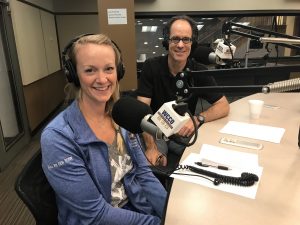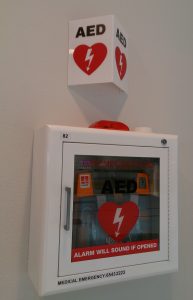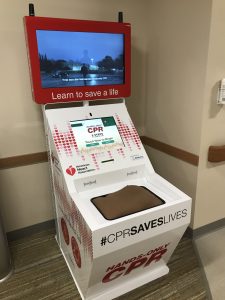Be brave. That is Alicia’s message.
This is undoubtedly the most powerful story we’ve yet told in 10 years of Healthy Matters broadcasts.
If you missed last week’s show, you missed a doozy of a personal story. Alicia Bravo is a nurse at Hennepin’s Emergency Department and just one year ago this healthy triathlete experienced a sudden cardiac arrest while swimming. Her dad and husband saved her life with CPR and now she is spreading the word about it. You’re going to want to listen to her tell the story on the podcast by clicking Listen to Podcasts at the right of this page.
To give us additional expertise, we were joined in the studio by Dr. Brad Bart, Director of Cardiology at Hennepin Healthcare. As a follow-up to the show, I asked each of them to respond to some written questions. What follows is from Alicia and Dr. Bart. There are powerful and wise words in this post, some links to helpful sites, a way you can donate to CPR education, and even an event that involves drinking beer.
I encourage you to read it through. You may save a life someday.
Please share this post on Facebook, Instagram, and with your friends by clicking the icons above. This is a message we need to get out!
Alicia’s story
Q: Tell us the story of your cardiac arrest.
Alicia Bravo:
“My family and I were vacationing in my home town of Cambridge, Wisconsin. It was a beautiful Saturday morning on July 1, 2017. I was training for a triathlon, and I decided to swim across the lake and run home. I asked my dad to trail me in the boat. He along with my sister, brother-in-law, my youngest son and my 3 nieces all were in the boat for a morning ride. About 5 minutes into the swim I stopped out of nowhere and said the word “help” to my father, he threw me a flotation device and I didn’t go after it. He knew I was in trouble. He yelled at my sister to go get me. She jumped in, fully clothed, and swam to the flotation device and then me. She said I whispered the word “breathe” two times before going limp in her arms. She swam me back to the boat, lifeless. My father reached down into the water and pulled me out, quickly realizing I did not have a pulse and I was not breathing. He immediately started CPR. My sister drove the boat back to the dock as my brother-in-law called 911 from the boat and my husband heard the screams and called 911 from the dock where he was fishing with my son.
My father, along with my husband and the boat police continued to do CPR until EMS arrived. I was still on the end of the narrow, long dock on the boat. EMS arrived and placed me on a backboard and the LUCAS machine and brought me to dry land. I had CPR for about 20 minutes before they placed a defibrillator on me and shocked me out of ventricular fibrillation. I then had return of spontaneous circulation…I had a pulse and was breathing but still unconscious.
I was brought to SSM Hospital in Madison, WI where they placed me in therapeutic hypothermia, my body was cooled for 24 hours and then slowly rewarmed. I remained in a “coma” on a ventilator during this time. The doctors informed my family that they were hoping for the best when I woke up, but were not sure if there would be any damage to my brain. They just had to wait.
I am here to say, I am a survivor and everything turned out perfectly! I have since been diagnosed with Long QT Syndrome. Treatment for this is an ICD and beta blocker-medication to keep my heart rate from going too high.”
Q: Why are you spreading the word about bystander CPR?
Alicia: “Spreading the word on bystander hands-only CPR and AED use has become my passion. It is a skill that can save a life. We need more survivors.”
Q: What three things should people know about CPR?
Alicia:
- CALL 911-we need to activate the chain of survival and get EMS notified ASAP.
- DO SOMETHING – start CPR. Push hard and fast in the center of the chest to the beat of “Staying Alive” by the Bee Gees, flag someone down to help if you are unable to perform CPR. Just do something. You can’t hurt someone who does not have a heartbeat or is not breathing.
- Tell someone to go get the AED (Automated External Defibrillator) or you get one as soon as possible. Early defibrillation along with immediate CPR can TRIPLE chance of survival. These are located in most public places. They are meant to be used by the public. Just turn it on, place the patches on the bare chest as the photos shows and listen to the machine, it will talk you through what to do.
What is a Sudden Cardiac Arrest?
Q: Dr. Bart, Alicia suffered a cardiac arrest and was saved by CPR and an AED. How successful is CPR compared to outcomes when it is NOT performed?
Dr. Brad Bart: “Bystander CPR makes a big difference. There are over 300,000 cases of sudden cardiac arrest each year in the US. The survival rate without bystander CPR is < 5%. Most large cities have effective emergency medical systems in place and with community efforts to deliver bystander CPR, the survival rate is about 15%. In Minneapolis, we are very fortunate to have a very advanced EMS system and great hospitals. Our survival rate is about 25% and is among the best in the country. This number could get higher with more bystander CPR!”
Q: “Why is quick defibrillation with an AED so important?”
Dr. Bart: “Quick defibrillation is critical in surviving a cardiac arrest. CPR can be lifesaving when performed early in a cardiac arrest while waiting for a defibrillator, but it is not as efficient as a true heartbeat. Restoring a true heartbeat with defibrillation is the only chance of survival. Even with great CPR, it is usually not possible to recover if there is no defibrillation quickly.”
Question from Healthy Matters listener: Explain the difference between cardiac arrest (what Alicia had) and heart attack.
Dr. Bart: “A cardiac arrest is usually an electrical problem with the heart that causes the usual heartbeat to stop. Without a heartbeat, no oxygen can get to the brain and this will lead to death within minutes. A heart attack is when heart muscle is damaged – usually in the setting of a blocked artery in the heart. When the heart muscle is damaged during a heart attack, it can sometimes cause problems with electrical conduction in the heart and this can lead to a cardiac arrest. So, even though some heart attacks can lead to a cardiac arrest, it is not the same thing as a cardiac arrest.”
Question from radio listener: Doesn’t the heart and brain need oxygen to work and get your heart working? (I like this question since it gets at the reason CPR works)
Dr. Bart: “Yes, the heart and brain (and everything else in your body) need oxygen to work. If you hold your breath for a minute, you won’t die – in fact, some people can hold their breath for over 20 minutes! The reason they don’t die is that they have a lot of oxygen on the red blood cells and dissolved in their blood stream (even though they are holding their breath). As long as the heart is pumping, this oxygen will get to the brain. During CPR, you are acting as the heart pump for someone else and you are keeping the blood circulating to the brain. If you can keep this up until trained healthcare professionals arrive, it should keep enough oxygen pumping to the brain, even without rescue breathing – of course all this needs to happen very quickly!”
Alicia is alive today because of a bunch of wonderful occurrences
Q: Alicia, you talked on the air about the “what if” scenarios around your arrest. Tell us about some of these.
Alicia: “There are SO many things about my story that showed the stars aligned and that is the reason I am alive today.
- When my dad got this boat about 8 years ago, he asked me what kind of seats I wanted. I wanted a back bench seat with a “lay out deck” instead of more bucket seats. Little did I know, this was the perfect spot for my dad to do CPR on me. He was able to kneel on the bench seat and I was on the lay out deck.
- In 2016, I was in Cambridge, WI the same weekend of the annual EMS fundraiser. It is a 5k or 10k they do to raise money. They are primarily a volunteer organization. In 2016, they were raising money to buy a LUCAS machine. I was so excited to help raise money for this, as I have seen the amazing work they do as a nurse in the emergency department. I can’t believe that almost 1 year later it would be used on me.
- I grew up on Lake Ripley, but I have never been a strong swimmer. I could “play around swim” in the water, but was never comfortable putting my face in the water. When I decided I wanted to do a triathlon, I took swimming lessons. My FIRST lesson was sitting on the stairs and putting my face in the water. Then I started to blow bubbles in the water. Soon I became an avid swimmer, but I really had to learn now.
- When it was time for open water swims, I would go out to swim with my husband and kids on the shore. Or with my friends with no one on the shore. The weekend before my sudden cardiac arrest (SCA) I swam a mile race.
- We were vacationing with my ENTIRE family for the first time in over 5 years at my parents’ house in Cambridge, WI. Without everyone there, things would have been very different.
- The FIRST time I had someone trail me in a boat was when I had my SCA. Not only was my father trailing me (he performed CPR), but my sister was in the boat (Swam to get me and swam me back to the boat then drove to the dock) along with my brother-in-law (called 911), 3 nieces and my youngest son.
- I had my SCA around 10:12 in the morning. “Wake time” (the time boaters are allowed to go fast enough to cause a wake in the water) is 11 am on Lake Ripley. When my sister drove the boat back as my father was giving me CPR, the boat police spotted my sister breaking wake rules and started to follow her, hearing the 911 call shortly after he was trailing her, he know where to go and he also assisted with CPR.
- My neighbor that lives behind my parents is on the fire department and heard the call and helped perform CPR and had a mask and helped with respirations.”
“Everything fell into place.”
Karma
This came from a listener text during the show: “We hear all this talk about karma, mostly bad. Alicia’s story is beautiful! Good karma.” (Keith from Bloomington)
Alicia: “Thank you Keith. I am so fortunate to have the outcome I did. I still remember every detail of the first time I did CPR on a man over 18 years ago. I remember thinking…’I am this man’s heartbeat, I am giving him every chance he has at this moment’. Over the past 16 years, I have assisted with resuscitation and performed CPR countless number of times. I don’t remember them all, but I remember thinking the same thing…’I am their heartbeat, we are doing everything we can.’
It feels good to know that I am still alive and give back. I want to continue to educate people on the importance of CPR. I want to empower others to be able to BE BRAVE and step in and be someone’s heartbeat, giving that person every chance they have to survive.
Q: Are you planning any future events to help spread the word about CPR?
Alicia: “Yes!!! I LOVE teaching and giving back to those in need. This year, we are doing a fundraiser called “Pump and Pints” for the city of Shakopee to raise money to purchase new AED’s. It will be at the Shakopee Brewhall on October 4th, 2018. It is an opportunity for people to learn hands-only CPR and how to use an AED in a friendly/non intimidating place. I did this last year at Surly Brewery and we raised $12,000 for Cambridge, WI EMS. We had over 200 people attend and taught 100 people CPR. I hope this year we can double the number of people who learn CPR.
Check out local news coverage of Alicia’s last Pump and Pint event:
(Hopefully we’ll see LOTS of Healthy Matters friends at the Shakopee Brewhall event on October 8, 2018!)
I also have a fundraising site that sells merchandise with a personalized design to raise awareness of Sudden Cardiac Arrest and the importance of CPR. It is an eye-catching design of an anatomical heart with an arrow going through it with the words Be Brave. I hope this shirt sparks conversations about SCA and CPR. I use this site as a fundraising site to the cause I am hosting…currently for the city of Shakopee to raise money for AED’s.
Alicia today
Q: How are you personally doing now, one year after your arrest? Are you active? Exercising? Any long-term problems you are having?
Alicia: “I am doing great!! I can do most things I did previously. I have run multiple 5ks, and did a triathlon in the spring…first leg being a kayak instead of swimming. I have multiple races scheduled for this summer. I have some discomfort with some exercises (heavy lifting above my head) since the placement of my ICD. I also loved to do high intensity interval training, HIIT. Instead I do MIIT- medium intensity interval training. I just have to keep my heart rate in a safe zone! The biggest thing I can no longer do is swim. If I were to be swimming and my heart would stop, my ICD would shock it back to normal, but in the mean time I could drown. It just isn’t safe for me anymore.
Q: What does it feel like, both physically and emotionally, to have an ICD in you?
Alicia: “Physically my ICD does not bother me but sometimes is a little sore/painful at times. It sticks out quite a bit and can be bothersome wearing certain clothes and with my seatbelt.
Emotionally, I feel very fortunate to have this life saving machine in my body. I feel safe.”
You can learn CPR!
Q: How can a person learn CPR?
Dr. Bart: “CPR is easy and just about anybody can do it. You don’t need to take a course (although a course is always good). Simply push hard and fast in the center of the victim’s breast bone – doing this, even without training is better than doing nothing! Another great way to gain confidence in doing CPR is by practicing on the CPR Kiosk at HCMC. Just go to the CSC building on 8th street, go to the second floor and walk across the skyway. The CPR kiosk is free and it’s there for everybody to practice on – it’s fun, too!”
Picking up an AED for your facility
Here’s a great question from a Healthy Matters listener who is really making a difference: “I have a commercial building. I would like to install an AED. What do I look for when purchasing one, and where do I get one?”
Dr. Bart: “Great question – I’m so glad you are thinking about getting an AED for your building! Prices range from about $1200 to $3000. In general, they all work, it’s a matter of what bells and whistles are important for your setting. Check out the American Heart Association – they have a nice website with the name and numbers for the major manufacturers. AED Universe also has some useful information about how to select an AED.”
Final words from Alicia
Q: What’s the main message you want people to know about CPR?
Alicia: “I want everyone to know they can make a difference. Be Brave and DO SOMETHING. You aren’t going to hurt someone by performing CPR, instead, you are going to give them every change they have to survive. You could be the reason they have another chance to kiss and hug their loved ones, you could be their reason they have another chance to do they things they love, be the reason they have another chance to laugh, another chance to make a difference in someone else’s live. You can be someone’s heartbeat at the time they need it most.”
Wow.
I want to thank Dr. Bart for his expertise. And to Alicia, I want to thank you for sharing your story and for showing us all how to Be Brave. We’re glad you’re here to inspire us all!
Subscribe by e-mail below if you wish and follow me on Twitter @DrDavidHilden
Please share this post on Facebook, Instagram, and with your friends. This is a message we need to get out.
David





